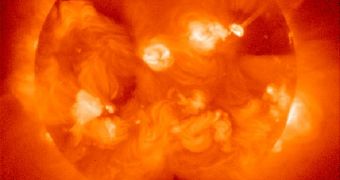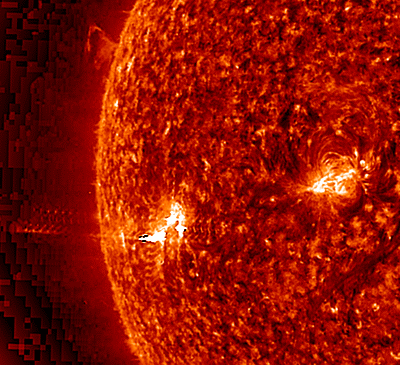For many years, scientists have observed elusive formations on the surface of the Sun, but have attributed them to being mere optical illusions, caused by the constant motion of the star's atmosphere. Just recently, the twin STEREO spacecraft managed to demonstrate that this was, in fact, not the case, and that the structures actually existed. Dubbed “solar tsunamis,” they are in fact massive, incredibly powerful waves of hot plasma, which create ripples just like a pebble thrown in a pond does. With the new observations, their existence has been finally proven, Space reports.
Though it may seem weird at first, you understand why the experts couldn't believe their eyes when they learned of the impressive traits that these formations had. One of them was noticed to bulge out from the surface of the Sun, to a height roughly equal to our planet's diameter, and then extended outwards in a circular pattern for several millions of miles. The phenomenon generated what is best described as a wall of plasma, which traveled at very high speeds from its origin, accumulating strength as it went along. This is what happens in the Earth's oceans when tsunamis occur, hence the name.
Some skeptical scientists suggested that the so-called tsunamis were in fact just plays of light, which created the appearance of shadows moving in the star's atmosphere. But they were proven wrong by the recent STEREO (Solar Terrestrial Relations Observatory) investigation. The observatory is actually made up of two identical spacecraft, which image their objective from completely different perspectives, offering one of the best vantage points of the star today. “Now we know. Solar tsunamis are real,” NASA Goddard Space Flight Center Solar Physics Laboratory expert Joe Gurman explains.
“It was definitely a wave. Not a wave of water, but a giant wave of hot plasma and magnetism,” George Mason University scientist Spiros Patsourakos adds. He is also the lead author of a new scientific paper detailing the finds, which appears in the latest issue of the Astrophysical Journal Letters. The expert made this assessment after looking at the STEREO observations, which were taken from positions separated by a 90-degree angle. The spacecraft identified the events in their February observation series, as they were surveying sunspot 11012. The target simply exploded at one point.
The phenomena have been scientifically named “fast-mode magnetohydrodynamical waves,” or MHD waves for short. They were found to be moving away from their point of origin at a speed of almost 560,000 miles per hour, and to have a height of 100,000 kilometers. According to early estimates, they might have well packed a force much higher than that of 2,400 megatons of TNT. “We've seen the waves reflected by coronal holes (magnetic holes in the sun's atmosphere). And there is a wonderful movie of a solar prominence oscillating after it gets hit by a wave. We call it the 'dancing prominence,'” Angelos Vourlidas, a scientist at the Solar Physics Branch of the Naval Research Laboratory's Space Science Division, concludes.
Keep an eye on the structure at the upper left side of the image, and watch how it wobbles after it gets hit by a solar tsunami. The event was not major, but enough to cause effects at extended distances. Credti: NASA
 14 DAY TRIAL //
14 DAY TRIAL // 